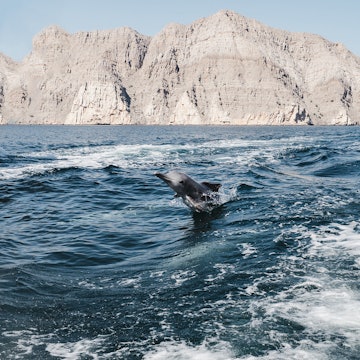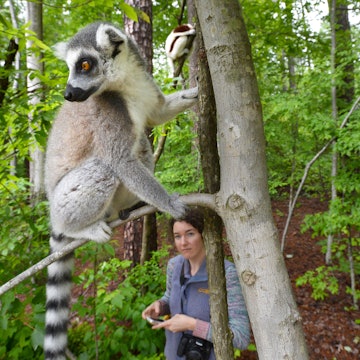

Time your trip for the dry season to get close to the island's famous lemurs. David Havel/Shutterstock
Madagascar is an adventurous destination, and for many visitors, a trip here is the adventure of a lifetime. But while it’s possible to visit year-round, when you come can greatly influence the kind of adventure you get to enjoy.
The climate of Madagascar can be divided into two very different seasons – the dry season (April to October) and the wet season (November to March), though there can be a little movement around the edges with these timings.
For example, sometimes the rains don’t arrive until December, or they can begin as early as October. In a damp year, the wet weather can persist into April, and in bad years, the rains don’t arrive at all. But as a rule, the dry-season months are the easiest for getting around, particularly when visiting national parks, and the wet is when you’ll share Madagascar with far fewer tourists.
Whichever of these scenarios appeals, read on for our guide to the best times to visit Madagascar.

June to August is the best time for good weather and the best road conditions
Welcome to Madagascar’s high season, when the best weather coincides with the summer holidays for much of the Northern Hemisphere. The result is an intense few months of busy roads and crowded beaches, and of higher prices and lower availability at the more popular resorts.
Even in the wettest years, rain is rare throughout most of the country during these months (although it can still rain along the east coast) and Madagascar’s notoriously poor roads have had time to dry out from even the latest wet-season thunderstorms.
Weather conditions, too, are ideal for exploring, with warm daytime temperatures and cool nights, tending toward downright cold in the highlands. Average nighttime temperatures in July can drop to around 8°C (46°F), including in the capital, Antananarivo, which sits at 1280m (4199ft) above sea level.
One particular highlight of traveling in Madagascar at this time is the chance to see migrating whales, often quite close to the shore. Humpbacks – known for launching out of the water in spectacular breaches – are the main draw, arriving along Madagascar’s eastern and western coasts around June.

Whales pass by the island en route between their feeding grounds in Antarctica and the warm waters of the Indian Ocean and Mozambique Channel where they breed. The whales usually remain until September before returning south, which should give you plenty of time for a sighting.
While all of this is happening out to sea, on land lemurs are giving birth, especially in August, with lots of cute lemur babies to see, and this is the best time for national park hikes. Trekking conditions are agreeable (tracks are not too muddy or slippery) and you can rely on parks such as Bemaraha and Ankarana – home to those weird-and-wonderful formations known as tsingy – being open. Many parks close in November and rarely reopen before April or May.
It's not just tourists who enjoy the ideal weather conditions. Locals spend most of their time outdoors, soaking up the sunshine and cool evenings and enjoying some of their favorite festivals. There’s no happier time to be in Madagascar than on 26 June, the country’s Independence Day, when the whole nation seems to turn red, green and white (the colors of the Madagascar flag).
It’s a time when you can look forward to anything from military parades and flag-waving crowds to street parties, themed nightclub nights, and celebrations of local flavors in the island's better restaurants. Come July and you may catch a hint of vanilla in the air, as Madagascar’s favorite (and most aromatic) crop starts to ripen, particularly in the far north.

May and September to November are good for wildflowers and smaller crowds
Many repeat visitors to Madagascar insist that the end of the dry season, from September to the start of November, is the best time to visit the country. By early September, most Europeans have returned home to school or work, and you can almost hear the country breathe a sigh of relief as the crowds thin. And while tourists may have departed, the humpback whales remain, lingering along the coast before beginning their long journey south.
As the dry season progresses, temperatures begin to rise, which may be perfect if you’re planning on spending time on the beach. The mercury stays high until the rains arrive. In November, occasional late-afternoon thunderstorms can cool things down for a few hours, but average daytime temperatures can reach 28°C (82°F) around Andasibe, and 30°C (86°F) around Isalo.
Generally, though, it’s dry and you’ll enjoy not having to fight for the best place on the beach or join a queue at the hotel buffet. Best of all, it’s a time of real, tropical abundance, with markets overflowing with fresh fruit and entire landscapes adorned with jacaranda trees, orchids and wildflowers in full bloom.
And the chances of seeing wildlife are as good as in the peak season, only now you’ll do so without the crowds. When it comes to wildlife encounters, October is the time of year when you'll hear the utterly compelling sound and fury of fossas (Madagascar’s largest carnivore) mating.
May can also be an exceptional month to visit. The rains have almost certainly passed and locals have a real spring in their step. Of the many festivals at this time of year, Donia in Nosy Be is the top pick – the celebrations last a week and this beautiful island escape can feel like one big, tropical party.

December to April is best for diving and Madagascar at its greenest
Madagascar is a world-class diving destination, and divers who know what they’re talking about swear by the water conditions in December. This is when you can expect the best underwater visibility and generally calm seas. This applies throughout the island, whether you opt for the dive sites of Nosy Be in the north, Île Sainte Marie in the east, or anywhere across the country’s south.
Another highlight of the rainy season months is the proliferation of wildlife. If you're keen to tick some of Madagascar's many chameleon species off your must-see list, reptiles and amphibians love the heat and humidity of February, when daytime temperatures rise above 32°C (90°F), emerging from hibernation in large numbers.
With so much rain around, seemingly everything in Madagascar turns green. And it’s a real refresher for the senses as forests fill with birdsong and the invigorating smell of recent rains hangs in the air. Prices for accommodation tend to be much lower as well.
One downside of these months, however, is the danger of cyclones, particularly on the east coast. These are possible any time from January to April – you’ll receive plenty of notice from locals when one is on the way, but they’re no fun when they arrive.
Less extreme, but also disruptive, is the aftermath of the heavy rains that generally fall from January to March. Roads and forest walking trails can turn to quagmires, making getting around more problematic than usual, and many national parks close or become inaccessible. Check the condition of roads before planning any long trip.













